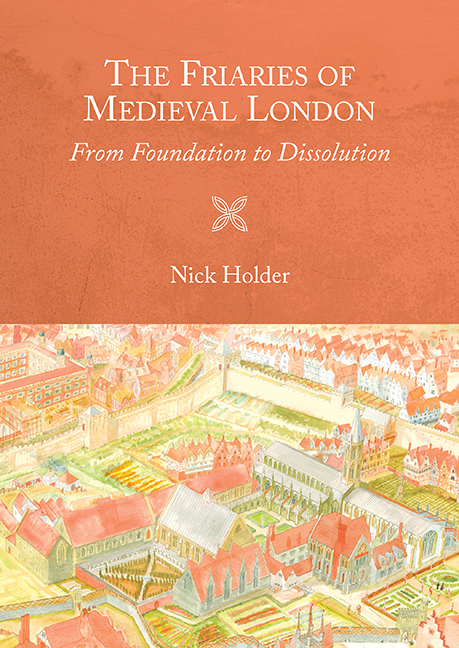Book contents
- Frontmatter
- Contents
- List of Illustrations and Tables
- Contributors
- Acknowledgements
- Abbreviations
- Introduction
- Part I The Nine London Friaries
- 1 The First Black Friars in Holborn, c. 1223–86
- 2 The Second Black Friars, 1275–1538
- 3 The Third Black Friars at St Bartholomew's, 1556–9
- 4 Grey Friars, 1225–1538
- 5 White Friars, c. 1247–1538
- 6 Austin Friars, c. 1265–1538
- 7 Crossed Friars, c. 1268–1538
- 8 Sack Friars, c. 1270–1305
- 9 Pied Friars, 1267–1317
- Part II The London Friars and their Friaries
- Conclusions
- Timeline
- Bibliography
- Index
- Miscellaneous Endmatter
2 - The Second Black Friars, 1275–1538
from Part I - The Nine London Friaries
Published online by Cambridge University Press: 16 May 2018
- Frontmatter
- Contents
- List of Illustrations and Tables
- Contributors
- Acknowledgements
- Abbreviations
- Introduction
- Part I The Nine London Friaries
- 1 The First Black Friars in Holborn, c. 1223–86
- 2 The Second Black Friars, 1275–1538
- 3 The Third Black Friars at St Bartholomew's, 1556–9
- 4 Grey Friars, 1225–1538
- 5 White Friars, c. 1247–1538
- 6 Austin Friars, c. 1265–1538
- 7 Crossed Friars, c. 1268–1538
- 8 Sack Friars, c. 1270–1305
- 9 Pied Friars, 1267–1317
- Part II The London Friars and their Friaries
- Conclusions
- Timeline
- Bibliography
- Index
- Miscellaneous Endmatter
Summary
BY the 1270s the Dominicans had acquired, planned and partly built a sizeable and convenient friary on one of the main approach roads to the walled city of London (Chapter 1: The First Black Friars in Holborn). However, between about autumn 1273 and summer 1275 the friars decided to move their priory into London itself. When royal permission was granted in October 1273 to obtain timber for building materials, the focus of the friars’ plans was still very much the Holborn friary, but by June 1275 Robert Kilwardby, the Dominican archbishop of Canterbury, was beginning to acquire the properties for a new friary site on the west side of the walled city. The project was particularly complex and ambitious: the large site comprised numerous properties and straddled the old Roman city wall. A remarkable planning meeting must have taken place in about 1274 to make the decision to move – a decision which would entail relocating a 225-yard stretch of the city wall of London! Complex negotiations must have taken place over the coming months between the prior, archbishop, mayor and king. The Dominicans certainly had a fortuitous combination of key personnel: John of Darlington, the prior or outgoing prior of the house, had been confessor to Henry III and was an experienced royal minister; the archbishop, Robert Kilwardby, had been the Dominican provincial prior and had plenty of experience of building new priories; and the mayor, Henry le Waleys, was a long-term friend to the mendicants and another favourite of the king with experience of urban building projects. As will be seen, the acquisition and construction of the new friary, including the additional requirement to build 565 yards (515m) of new city wall, was to take place in a remarkably short time.
The refounded Dominican friary was the largest, wealthiest and most politically significant of the English friaries. It housed nearly a hundred friars at the turn of the thirteenth and fourteenth centuries and still had about sixty in the late fourteenth century after the effects of the Black Death. The friary contained the order's studium provinciale, which trained English and some foreign Black friars and sent them on for higher study at Oxford, Cambridge and Continental universities.
- Type
- Chapter
- Information
- The Friaries of Medieval LondonFrom Foundation to Dissolution, pp. 27 - 56Publisher: Boydell & BrewerPrint publication year: 2017



